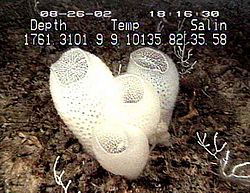glass sponge
Appearance
English
[edit]
Noun
[edit]glass sponge (plural glass sponges)
- Any species of the class Hexactinellida of sponges, which have a skeleton made of four-pointed or six-pointed siliceous spicules.
- 1996, Carroll Lane Fenton, Pat Vickers Rich, Mildred Adams Fenton, Thomas H. V. Rich, The Fossil Book: A Record of Prehistoric Life, Revised Edition 1989, New Corrections 1996, page 114,
- Glass sponges are rare in the Ordovician and Silurian but are preserved in enormous numbers in Late Devonian formations of western New York.
- 2007, S. P. Leys, G. O. Mackie, H. M. Reiswig, “The Biology of Glass Sponges”, in D. W. Sims, editor, Advances in Marine Biology, volume 52, page 85:
- Glass sponges are found in deep water (greater than 500 m) in all oceans of the world, but only inhabit shallower waters (up to 20 m) in four known locations: Antarctica, southern New Zealand, submarine caves in the Mediterranean and coastal waters of the north Pacific.
- 2016, Samantha M. Gromek, Ashley M. West, Marcy J. Balunas, “Chapter 12: Off the Beaten Path: Natural Products from Extreme Environments”, in Bill J. Baker, editor, Marine Biomedicine: From Beach to Bedside, page 344:
- Within the phylum Porifera is the class Hexactinellida, commonly known as glass sponges, which, until recently, remained largely unstudied due to past interests in another class, Demospongiae.[25] Glass sponges are typically found in marine environments at depths ranging from 200 to 6000 m, but have also been found to live at shallower depths.
- 1996, Carroll Lane Fenton, Pat Vickers Rich, Mildred Adams Fenton, Thomas H. V. Rich, The Fossil Book: A Record of Prehistoric Life, Revised Edition 1989, New Corrections 1996, page 114,
Synonyms
[edit]- (any species of Hexactinellida): hexactinellid, hexactinellid sponge
See also
[edit]References
[edit] Glass sponge on Wikipedia.Wikipedia
Glass sponge on Wikipedia.Wikipedia  Hexactinellida on Wikispecies.Wikispecies
Hexactinellida on Wikispecies.Wikispecies  Category:Hexactinellida on Wikimedia Commons.Wikimedia Commons
Category:Hexactinellida on Wikimedia Commons.Wikimedia Commons
